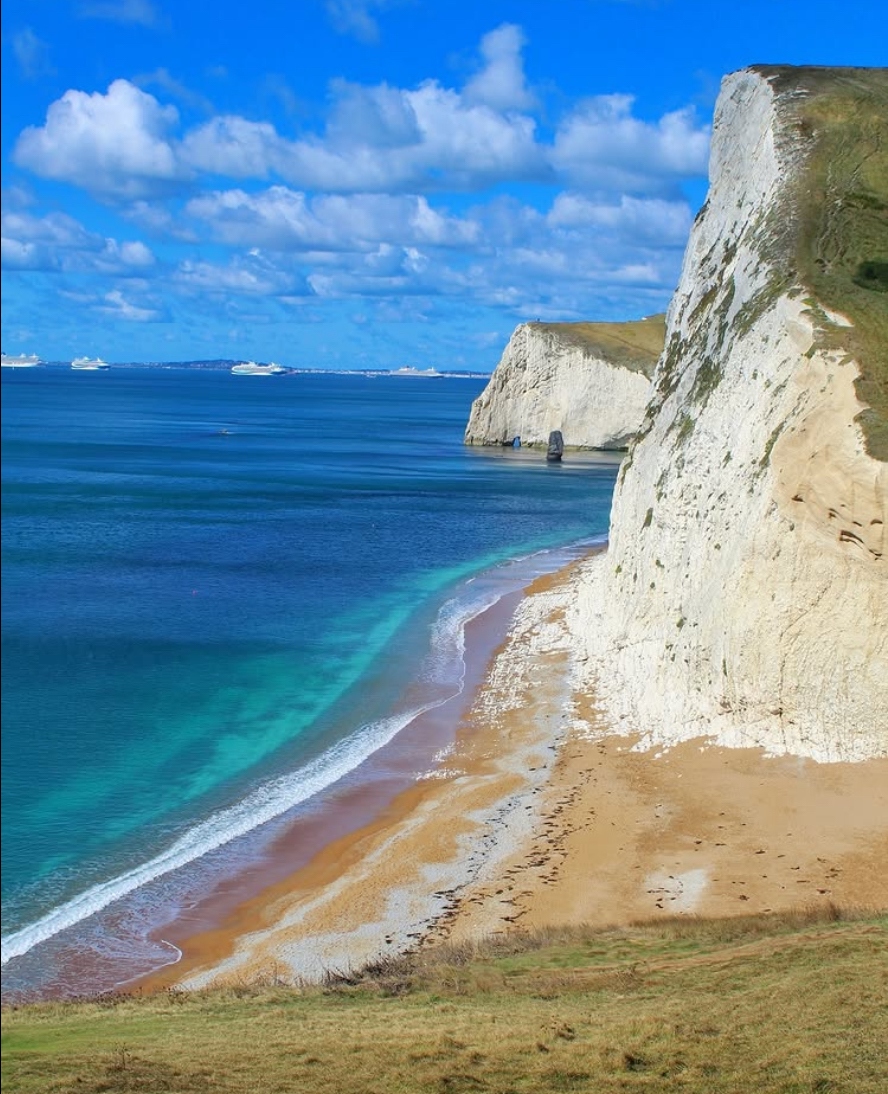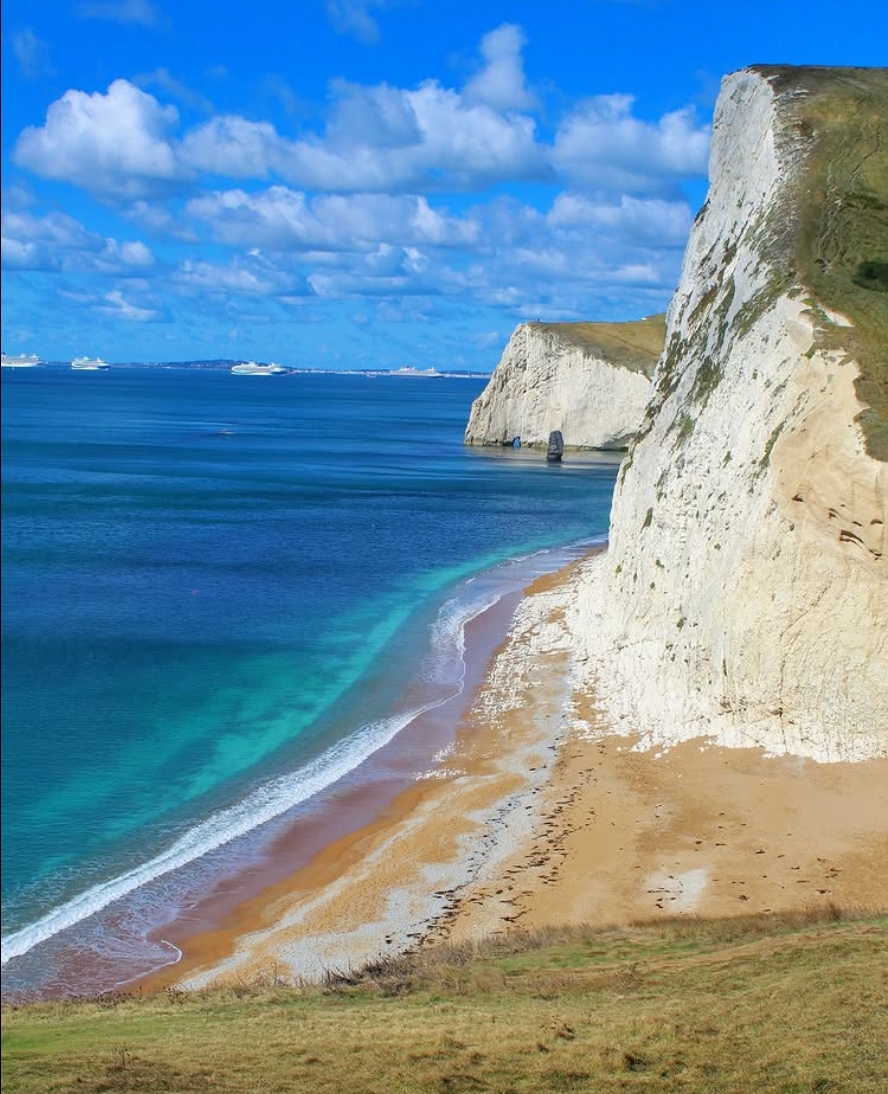The Jurassic Coast stretches along Dorset's coastline, as a living timeline of 185 million years of Earth’s history, laid bare in its cliffs, beaches, and fossils.
Geological Story
The coast covers three geological periods—Triassic, Jurassic, and Cretaceous—unfolding from west to east:
- Triassic (252-201 million years ago): Red cliffs near Exmouth reveal ancient deserts, with ripple marks and mudstones from a time before dinosaurs ruled.
- Jurassic (201-145 million years ago): Dorset’s heart—think Lyme Regis and Charmouth—shows blue-grey limestone and shale packed with marine fossils like ammonites and belemnites, from when this was a tropical seabed.
- Cretaceous (145-66 million years ago): Chalk stacks like Old Harry Rocks and Golden Cap mark a younger era of warm seas and early flowering plants.
This “walk through time” is why geologists flock here—it’s a rare, continuous sequence exposed by erosion, not textbooks.
Iconic Landmarks
- Durdle Door: A natural limestone arch near Lulworth, carved by waves—stunning from the South West Coast Path or by kayak.
- Lulworth Cove: A near-perfect horseshoe bay, formed when the sea breached softer rock behind a hard limestone wall. Pair it with the nearby Fossil Forest, where 145-million-year-old tree stumps peek from the cliffs.
- Golden Cap: At 191 meters, the highest point on England’s south coast, its golden sandstone glows atop dark clay—a 7-mile hike from Seatown pays off with 360-degree views.
- Chesil Beach: An 18-mile shingle barrier, sloping steeply into the sea, connecting Portland to the mainland. Its pebbles famously grade from pea-sized to fist-sized west to east.
- Old Harry Rocks: White chalk stacks off Studland, sculpted by millennia of tides—legends tie them to pirates and the devil.
Fossils and Fossil Hunting
The coast is a treasure trove for fossil hunters:
- Lyme Regis and Charmouth: Nicknamed the “fossil capital,” these beaches yield ammonites, ichthyosaur bones, and even dinosaur footprints after storms loosen the cliffs. Mary Anning, a 19th-century pioneer, found her first plesiosaur here at age 12.
- Tips: Hunt at low tide, post-storm, with a hammer and chisel (safely—cliffs are unstable). Guided walks from Charmouth Heritage Coast Centre or Lyme Regis Museum up your odds.
Wildlife
The coast teems with life:
- Marine: Dolphins and seals swim off Kimmeridge, while tide pools harbor crabs, anemones, and blennies. Studland Bay’s seagrass hides rare seahorses.
- Birds: Portland Bill hosts puffins and guillemots; peregrines dive from cliffs.
- Reptiles: Sand lizards bask on dunes near Purbeck.
Activities
- Walking: The South West Coast Path traces the entire coast—tackle short loops like the 3-mile Old Harry Rocks or the 5-mile Durdle Door stretch.
- Kayaking: Paddle from Weymouth or Lulworth to see arches and caves up close—Fore Adventure offers tours.
- Coasteering: Swim, climb, and jump along Purbeck’s cliffs with outfits like Land & Wave.
- Photography: Sunrise at Golden Cap or dusk at Chesil Beach captures the coast’s drama.
Practical Bits
- Access: Key hubs like Weymouth, Lyme Regis, and Swanage have parking (£2-10/day) and buses (Morebus, First). Paths are free but rugged—bring boots.
- Safety: Cliffs crumble—stick to trails and check tides (BBC Weather or tide apps). Fossil hunting’s regulated; take only loose finds, not cliff-dug ones.
- Season: Spring and autumn dodge crowds; winter storms unearth fossils but muddy trails.
Cultural Echoes
The coast inspired Thomas Hardy’s novels and John Fowles’ The French Lieutenant’s Woman. Lyme Regis honors Mary Anning with a museum, while the Etches Collection in Kimmeridge displays jaw-dropping local finds like a 6-foot pliosaur skull.

